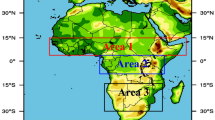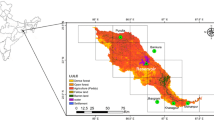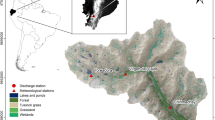Abstract
Normalized difference vegetation index (NDVI) data, obtained from remote sensing information, are essential in the Shuttleworth-Wallace (S-W) model for estimation of evapotranspiration. In order to study the effect of temporal resolution of NDVI on potential evapotranspiration (PET) estimation and hydrological model performance, monthly and 10-day NDVI data set were used to estimate potential evapotranspiration from January 1985 to December 1987 in Huangnizhuang catchment, Anhui Province, China. The differences of the two calculation results were analyzed and used to drive the block-wise use of the TOPMODEL with the Muskingum-Cunge routing (BTOPMC) model to test the effect on model performance. The results show that both annual and monthly PETs estimated by 10-day NDVI are lower than those estimated by monthly NDVI. Annual PET from the vegetation root zone (PETr) lowers 9.77%–13.64% and monthly PETr lowers 3.28%–17.44% in the whole basin. PET from the vegetation interception (PETi) shows the same trend as PETr. In addition, temporal resolution of NDVI has more effect on PETr in summer and on PETi in winter. The correlation between PETr as estimated by 10-day NDVI and pan measurement (R 2 = 0.835) is better than that between monthly NDVI and pan measurement (R 2 = 0.775). The two potential evapotranspiration estimates were used to drive the BTOPMC model and calibrate parameters, and model performance was found to be similar. In summary, the effect of temporal resolution of NDVI on potential evapotranspiration estimation is significant, but trivial on hydrological model performance.
Similar content being viewed by others
References
Ao Tianqi, 2001. Development of a distributed hydrological model for large river basins and its application to Southeast Asian rivers. Kofu: University of Yamanashi.
Ao Tianqi, Ishidaira H, Takeuchi K, 1999. Study of distributed runoff simulation model based on block type TOPMODEL and Muskingum-Cunge method. Annual Journal of Hydraulic Engineering, JSCE 43, 7–12. (in Japanese)
Ao Tianqi, Takeuchi K, Ishidaira H, 2000. On problems and solutions of the Muskingum-Cunge routing method applied to a distributed rainfall runoff model. Annual Journal of Hydraulic Engineering, JSCE 44, 139–144. (in Japanese)
FAO, 1995. Digital Soil Map of the World and Derived Soil Properties (CD-ROM). Rome: FAO.
Federer C A, Vorosmarty C J, Fekete B, 1996. Intercomparison of methods for potential evapotranspiration in regional or global water balance models. Water Resources Research, 32(7), 2315–2321.
Kaufmann R K, Zhou L, Myneni R B et al., 2003. The effect of vegetation on surface temperature: A statistical analysis of NDVI and climate data. Geophysical Research Letters, 30(22): 21–47. DOI: 10.1029/2003GL018251.
Loveland T R, Reed B C, Brown J F et al., 2000. Development of a global land cover characteristics database and IGBP DIS-Cover from 1-km AVHRR data. International Journal of Remote Sensing, 21(6–7): 1303–1330.
New M, Hulme M, Jones P, 1999. Representing twentieth-century space-time climate variability. Part I: Development of a 1961–90 mean monthly terrestrial climatology. Journal of Climate, 12(3): 829–856.
Nicholson S E, Lare A R, Marengo J A et al., 1996. A revised version of Lettau’s evapoclimatonomy model. Journal of Applied Meteorology, 35(4): 549–561.
Running S W, Nemani R R, 1988. Relating seasonal patterns of the AVHRR vegetation index to simulated photosynthesis and transpiration of forests in different climates. Remote Sensing Environment, 24(2): 347–367.
Seevers P M, Ottmann R W, 1994. Evapotranspiration estimation using a normalized difference vegetation index transformation of satellite data. Hydrological Sciences Journal, 39(4): 333–345.
Shuttleworth W J, Wallace J S, 1985. Evaporation from sparse crops—An energy combination theory. Quartly Journal of Royal Meteorology Society, 111: 839–855.
Stannard D I, 1993. Comparison of Penman-Monteith, Shuttle-worth-Wallace, and modified Priestley-Taylor evapotranspiration models for wildland vegetation in semiarid rangeland. Water Resources Research, 29(5): 1379–1392.
Szilagyi J, 2002. Vegetation indices to aid areal evapotranspiration estimations. Journal of Hydroelectric Engineering, 7(5): 368–372.
Takeuchi K, 2006. Virtual Academy YHyM/BTOPMC 2006 course. COE, University of Yamanashi. http://coeinav.cec.yamanashi.ac.jp/inavi. (July 2006).
Takeuchi K, Ao T, Ishidaira H, 1999. Introduction of block-wise use of TOPMODEL and Muskingum-Cunge method for the hydro-environmental simulation of a large ungauged basin. Hydrological Sciences Journal, 44(4): 633–646.
Vorosmarty C J, Federer CA, Schloss A L, 1998. Potential evaporation functions compared on US watersheds: Possible implications for global-scale water balance and terrestrial ecosystem modeling. Journal of Hydrology, 207(3): 147–169.
Zhou M C, Ishidaira H, Hapuarachchi H P et al., 2006a. Estimating potential evapotranspiration using Shuttleworth-Wallace model and NOAA-AVHRR NDVI data to feed a distributed hydrological model over the Mekong River basin. Journal of Hydrology, 327(1–2): 151–173.
Zhou M C, Ishidaira H, Takeuchi K, 2006b. Estimating the potential evapotranspiration over the Yellow River by considering the land cover characteristics. IAHS Publication, 303: 214–225.
Author information
Authors and Affiliations
Corresponding author
Additional information
Foundation item: Under the auspices of National Basic Research Program of China (No. 2006CB400502)
Rights and permissions
About this article
Cite this article
Li, X., Ren, L. Effect of temporal resolution of NDVI on potential evapotranspiration estimation and hydrological model performance. Chin. Geogr. Sci. 17, 357–363 (2007). https://doi.org/10.1007/s11769-007-0363-6
Received:
Accepted:
Issue Date:
DOI: https://doi.org/10.1007/s11769-007-0363-6




